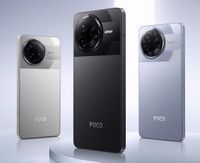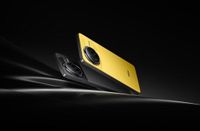Xiaomi's Poco brand has officially unveiled its latest flagship smartphones, the Poco F7 Ultra and Poco F7 Pro, during a launch event in Singapore on March 26, 2025. These devices are positioned as formidable contenders in the smartphone market, boasting advanced features and competitive pricing.
The Poco F7 Ultra is powered by the cutting-edge Qualcomm Snapdragon 8 Elite processor, built on a 3nm process, making it one of the most powerful chipsets available in Android smartphones today. This model also includes the VisionBoost D7 coprocessor, which significantly enhances graphics performance, particularly in gaming and high-definition content.
Equipped with a 6.67-inch Flow AMOLED display, both the F7 Ultra and F7 Pro feature a stunning 3200 x 1440 pixel resolution and a refresh rate of 120 Hz. The display can achieve a peak brightness of 3200 nits, ensuring excellent visibility even in bright sunlight. For added durability, the F7 Ultra's screen is protected by Poco Shield Glass, while the F7 Pro utilizes Corning Gorilla Glass 7i.
In terms of memory and storage, the Poco F7 Ultra offers options of 12 or 16 GB of LPDDR5X RAM and 256 or 512 GB of UFS 4.1 storage. The F7 Pro, on the other hand, is available with 12 GB of RAM and similar storage configurations. Both models run on Android 15 with Xiaomi's HyperOS 2, which incorporates advanced features such as HyperCore, HyperConnect, and HyperAI technologies, enhancing overall device performance and user experience.
The camera systems on both models are impressive as well. The Poco F7 Ultra features a triple-camera setup, including a 50 MP main sensor based on the Light Fusion 800 technology, which supports optical image stabilization (OIS). This is complemented by a 50 MP telephoto lens with 2.5x optical zoom and a 32 MP ultra-wide-angle camera, offering a 120-degree field of view. The front camera is a robust 32 MP sensor, ideal for high-quality selfies and video calls.
In contrast, the Poco F7 Pro comes with a slightly less complex camera system, featuring the same 50 MP main sensor but paired with an 8 MP ultra-wide-angle lens and a 20 MP front camera. Both devices support video recording up to 8K at 24 frames per second, making them suitable for high-resolution video content creation.
Battery life is another strong point for these smartphones. The Poco F7 Ultra is equipped with a 5300 mAh battery that supports 120 W fast charging, allowing for a full charge in just 34 minutes. It also offers 50 W wireless charging capabilities. The Poco F7 Pro has a larger 6000 mAh battery with 90 W fast charging support, ensuring extended usage time even with heavy applications.
Both models feature IP68 dust and water resistance, making them resilient against the elements. Xiaomi has also integrated the Poco Surge G1 chipset into both devices, optimizing power consumption and extending battery longevity, with the company claiming that the batteries retain 80% of their original capacity even after 1600 charge cycles.
Pricing for the Poco F7 Ultra starts at $649 (or €749) for the 12/256 GB variant, while the 16/512 GB version is priced at $699 (or €799). The Poco F7 Pro is more budget-friendly, with prices beginning at $499 (or €599) for the 12/256 GB model and $549 (or €649) for the 12/512 GB variant. Pre-orders for both models have already begun, with availability in various markets including Europe and Ukraine.
In Ukraine, the Poco F7 Pro is priced at approximately 22,999 UAH for the 12/256 GB version and 24,999 UAH for the 12/512 GB configuration. Meanwhile, the Poco F7 Ultra will retail for 31,999 UAH for the 12/256 GB version and 34,999 UAH for the 16/512 GB model. These prices reflect a competitive offering in the flagship smartphone segment, appealing to consumers looking for high-end features without the flagship price tag.
The introduction of the Poco F7 series reinforces Xiaomi's commitment to delivering powerful, affordable smartphones that cater to a wide range of users. With their impressive specifications and competitive pricing, both the Poco F7 Ultra and F7 Pro are poised to become popular choices among smartphone enthusiasts in 2025.






